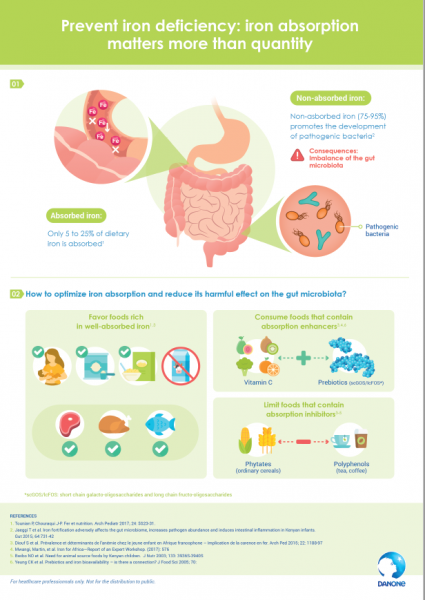Only 5-25% of ingested iron is actually absorbed, and the increase in the quantity of unabsorbed dietary iron in the colon imbalances the gut microbiota1,2. Therefore, the bioavailability of dietary iron should be preferred over its quantity.
HePCIDIN AT THE heart of iron metabolism
The amount of iron in the body is extremely stable thanks to mechanisms that precisely regulate: the absorption, recycling and mobilization of iron3. It is hepcidin, a hyposidemic hormone secreted by the liver, that regulates the body’s iron concentration as needed, controlling the absorption of dietary iron and the recycling of iron by macrophages3,4. Its expression is impacted by various factors such as iron status, anemia and inflammation3.
The negative IMPACTs of unabsorbed iron on THE GUT microbiota
On average, less than 25% of the dietary iron is actually absorbed into the body 4. The rate of iron absorption varies greatly from one food to another. For example, the absorption rate of iron in cow’s milk is only 1-5% when it is 10-20% in infant formula4. The bioavailability will therefore have a significant influence on the actual amount that will be absorbed.
The remaining 75-95% of unabsorbed iron, reach the colon and alter the balance of the gut microbiota by promoting pathogenic bacteria at the expense of host-beneficial bacteria1,2. This causes an imbalance of the gut microbiota and tends to increase the occurrence of digestive disorders such as diarrhea1,2.
Taking the iron bioavailability into account helps to cover the necessary iron requirements and avoids surpluses of unabsorbed iron into the gut microbiota.
HOW to optimize Iron Absorption
Iron bioavailability depends on the chemical form ingested – heminic or non-heminic iron – and the composition of the meal4. Heminic iron is found in meat products and its intestinal bioavailability is 25%. Non-heminic iron is present in plant-based foods and has an intestinal bioavailability of 1 to 5%4. Iron absorption is strongly influenced by the components of the meal that can increase it (such as vitamin C or prebiotics scGOS/lcFOS*) or decrease it (such as phytates or polyphenols)4,5.
To learn more about how prebiotics (scGOS/lcFOS*) allow better iron absorption, click here.
Find the interview with Professor Mohamed Chemseddine Smahi at the 11th edition of the African Meeting of Infant Nutrition (RANI) on the role of nutrition in preventing iron deficiency:

Infography : Prevent iron deficiency, iron absorption matters more than quantity
References
- Jaeggi T et al. Iron fortification adversely affects the gut microbiome, increases pathogen abundance and induces intestinal inflammation in Kenyan infants. Gut 2015; 64: 731-42.
- Zimmermann MB et al. The effects of iron fortification on the gut microbiota in African children: A randomized controlled trial in Côte d’Ivoire. Am J Clin Nutr 2010; 92: 1406-15
- Vaulont S. Métabolisme du fer. Arch Pediatr 2017; 24: 5S32-9.
- Tounian P, Chouraqui J-P. Fer et nutrition. Arch Pediatr 2017; 24: 5S23-31.
- Christides T et al. In vitro assessment of iron availability from commercial young child formula supplemented with prebiotics. Eur J Nutr 2016. DOI 10.1007/s00394-016-1353-3.
BA20-464
